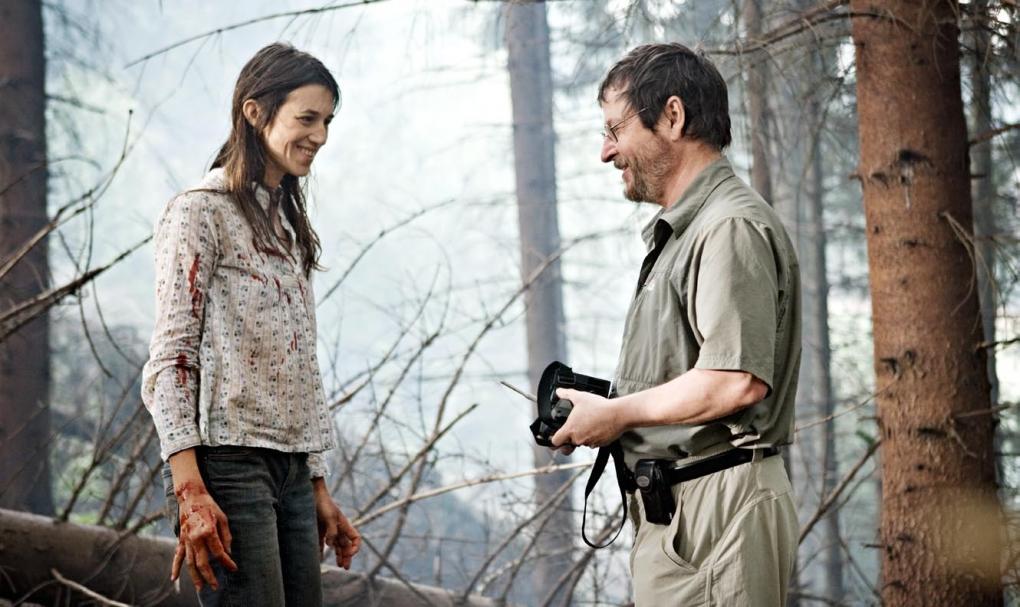Lars von Trier’s relationship to his actors resembles an intense drama fraught with love-hate, though no simple formula applies. The Danish director’s approach to his players has changed radically over the 11 films of his career.
"I don't think I would have been able to trust any other director looking to push me to such extremes. From the outset, he said, 'Relax, I would never use a cut you're not comfortable with. I'm on your side.' And I trusted him completely. I gave him complete control of me. It was very intense and painful experience, but I wanted it that way. I must have been very masochistic at the time. It wasn't a pleasure, but felt good deep inside." Charlotte Gainsbourg on working with Lars von Trier in Ekko magazine
Naturally, the conflicts have been most widely reported, none more so than his high-voltage clash with the Icelandic vocalist Björk on the set of "Dancer in the Dark" (2000), which drove her to literally flee into the unknown, jeopardising the film’s completion.
SOUL QUAKES
Laying herself open to von Trier’s probing psychoanalytical direction also rocked Anne Louise Hassing to the core when she played Susanne, the “spaz” collective’s somewhat more grounded caregiver in von Trier’s Dogme film "The Idiots" (1998).
She was asked at the time if she would ever work with von Trier again after what she’d been through.
“I would, definitely. But if he’d asked me right after the shoot I would have said no. I was spent. Now I know it’s a gift to work with him,” she said. Nicole Kidman had a similar, mixed experience on "Dogville" (2003).
“One day it would be a fairy tale, the next it was a nightmare. Lars was gentle with me – he was gentle and soft, then he would beat me up emotionally when he felt he needed that,” she said.
UNAFRAID TO TAKE RISKS
All the same, von Trier’s unconventional methods, his contentious personality and of course the great parts he writes is generally more alluring than off-putting to most actors who have faith in cinema as a soul-stirring adventure. No other Scandinavian director has worked with so many internationally acclaimed actors and stars as von Trier.
The list includes Nicole Kidman, Stellan Skarsgård, Emily Watson, James Caan, Chloë Sevigny, Ben Gazzara, Jean-Marc Barr, Katrin Cartlidge, Lauren Bacall, Barbara Sukowa, Danny Glover, Harriet Andersson, Paul Bettany and Eddie Constantine.
Now, von Trier’s new film "Antichrist" is adding the French actress Charlotte Gainsbourg to the already star-studded list, which already includes her co-actor in the film, American star Willem Dafoe, who played Grace’s father in Manderlay. Unafraid to take risks, the two talented actors are collaborators after von Trier’s heart. Dafoe once said: “I never act. I simply bring out the real animal that’s in me.” It’s not hard to picture von Trier nodding in approval.
STRIVING FOR AUTHENTICITY
Early on, von Trier had a rather detached relationship to his actors. In "The Element of Crime" (1984) and "Europa" (1991), he moved his characters around like marionettes in a carefully controlled mise-en-scène.
He only started easing up on his rigid control in "The Kingdom" (1994 & 1997) when he started working with a hand-held camera, which gave his actors much more freedom. As always, von Trier made a radical stylistic choice – he could hardly have been getting farther away from his earlier, tightly controlled storytelling form. Assisted by co-director Morten Arnfred, von Trier coaxed dramatically more human performances from his actors than in his first, rather stiffly acted films.
As von Trier discovered, setting the camera free and using available lighting greatly increased the conditions for expressiveness, authenticity and spontaneity in the acting.
A central aspect of the Dogme theory thus was tested in practice, enabling the stylistic double move in "Breaking the Waves" (1996) – over-the-top melodrama shot with a documentary-realistic hand-held camera! Having loosened the straightjacket of technique, von Trier went on to shoot his Dogme film "The Idiots" (1998) under primitive technical conditions, manning the camera himself.
In "Dogville" (2003) and "Manderlay" (2005), von Trier presented a new version of extreme stylisation. Now, the actors were practically all that remained on a naked stage in an empty, imaginary space. Even so, the acting is never theatrical but strives for authenticity, same as in the Dogme film.
